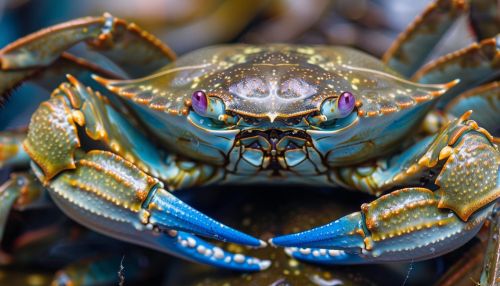Blue crab
Overview
The blue crab, scientifically known as Callinectes sapidus, is a species of crab native to the western Atlantic Ocean and the Gulf of Mexico. This species is of significant ecological and economic importance, particularly in the Chesapeake Bay region. The blue crab is renowned for its distinctive blue claws and olive-green carapace, and it plays a crucial role in the marine food web as both predator and prey.


Taxonomy and Classification
The blue crab belongs to the family Portunidae, which includes swimming crabs characterized by their flattened, paddle-like rear legs. The genus Callinectes comprises several species, but C. sapidus is the most well-known and widely studied. The species name sapidus means "savory" or "tasty," reflecting its value as a seafood delicacy.
Morphology
Blue crabs exhibit sexual dimorphism, meaning males and females have distinct physical differences. Males, known as "Jimmies," have bright blue claws and a narrow, T-shaped abdomen. Females, referred to as "Sooks," have red-tipped claws and a broader, dome-shaped abdomen. The carapace of an adult blue crab can reach up to 9 inches in width.
The exoskeleton of the blue crab is composed of chitin, a polysaccharide that provides both strength and flexibility. This exoskeleton must be periodically shed and replaced through a process known as molting, which allows the crab to grow.
Habitat and Distribution
Blue crabs are found in estuarine environments along the Atlantic coast from Nova Scotia to Argentina. They thrive in brackish waters where freshwater and saltwater mix, such as bays, lagoons, and river mouths. The Chesapeake Bay is one of the most productive habitats for blue crabs, supporting a large population and a robust fishery.
Life Cycle and Reproduction
The life cycle of the blue crab includes several stages: egg, larva, juvenile, and adult. Female blue crabs can produce up to two million eggs per brood, which are carried under their abdomen until they hatch. The larvae, known as zoeae, undergo multiple molts before transforming into megalopae, which eventually settle to the bottom and develop into juvenile crabs.
Mating typically occurs during the summer months when females undergo their terminal molt and become receptive to males. After mating, females migrate to higher salinity waters to spawn, ensuring the survival of their offspring.
Feeding Behavior
Blue crabs are omnivorous scavengers, feeding on a wide variety of plant and animal matter. Their diet includes bivalves, small fish, detritus, and even other crabs. They use their powerful claws to capture and manipulate prey, and their specialized mouthparts to shred and consume food.
Ecological Role
As both predators and prey, blue crabs play a vital role in the estuarine ecosystem. They help control populations of benthic invertebrates and serve as a food source for larger predators such as fish, birds, and humans. Their scavenging behavior also contributes to the decomposition and recycling of organic matter.
Fisheries and Economic Importance
The blue crab fishery is one of the most valuable in the United States, particularly in the Chesapeake Bay region. Crabbing is conducted using various methods, including crab pots, trotlines, and dip nets. The fishery supports both commercial and recreational activities, providing significant economic benefits to coastal communities.
Conservation and Management
Blue crab populations are subject to fluctuations due to environmental factors, overfishing, and habitat degradation. Effective management practices are essential to ensure the sustainability of the fishery. These practices include setting harvest limits, protecting spawning females, and restoring critical habitats such as underwater grasses and oyster reefs.
Research and Studies
Ongoing research on blue crabs focuses on understanding their biology, behavior, and interactions with the environment. Studies on molting cycles, reproductive biology, and migration patterns provide valuable insights for managing crab populations. Additionally, research on the impacts of climate change and pollution on blue crabs is crucial for developing adaptive management strategies.
